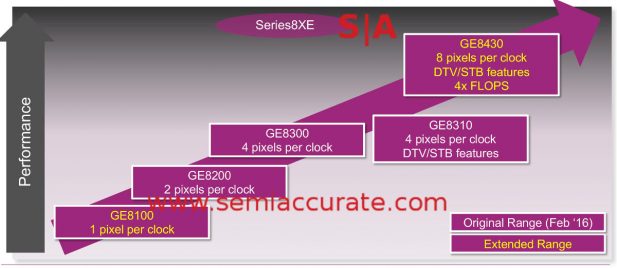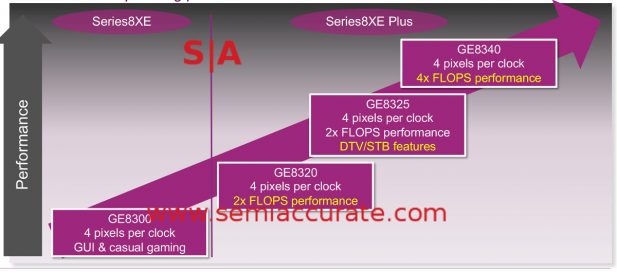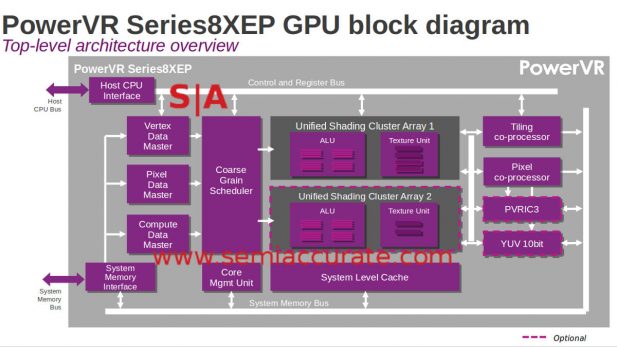![]() Yesterday Imagination released a new line of upgraded mid-range GPU core called Series 8XE Plus. If mid-range GPU cores are exciting to you, SemiAccurate has an exciting set of IP offerings to tell you about.
Yesterday Imagination released a new line of upgraded mid-range GPU core called Series 8XE Plus. If mid-range GPU cores are exciting to you, SemiAccurate has an exciting set of IP offerings to tell you about.
About a year ago in February 2016, Imagination released their first 8-series offering in mid-range 8XE form. They later filled it out by extending the range from its older 2-4 pixels per clock (PPC) range to the new 1-8PPC range. This is the long way of saying that the 8XE line can scale from 1/4 to 2 clusters of 4PPC each. 8100 = 1PPC, 8200 = 2PPC, 8300 = 4PPC, and 8400 = 8PPC for the pedantic.

Series 8XE pre-Plus lineup
The 8XE line is aimed squarely at the low-end 1080p TV market without high-end features, phones with 720p screens, and simple digital dashboards. Think cost sensitive markets without the need for high-end gaming or effects like it on non-game applications. This is about the best definition of mid-range, the fill rate to push 1080p but not the FLOPS to do much fancy work at that rez. It is a big market.

Series 8XE post-Plus lineup
That brings us to the new trio of IP offerings that make up the Series 8XE Plus, the GE8320, GE8325, and GE8340. What do they bring to the table, or to put it more bluntly if these offerings are part of the 8300 family, why the plus? That can be explained by pointing out the 4PPC range is the sweet spot for the line, it pushes 1080p screens well so the big hole in the 8XE line is FLOPS.

Series 8XEP block diagram
That is where the 8XE Plus, oh lets call it 8XEP from now on to save endangered pixels. Note the optional part on the texture units above, you can have one cluster of four Texture Units or two clusters of two TUs, both of which get you to the 4PPC count in all cases. The rest of the optional bits are fixed, in the non-Plus the texture pipes could range from 1-4. Lack of flexibility in a modern IC tends to result in lower die area and thus lower costs. 4PPC is what you need for the volume market so that is fixed and the rest is optimized for area, hence the 8XEP line.
Both 8XE and 8XEP supports all the goodies, virtualization, multiple level security, Vulkan 1.0, OpenCL 1.2 EP, OpenVX 1.1, and OpenGL ES 3.2. Imagination claims their GPU is 45% smaller than the competition at the 4PPC point with the new 8XEP being 30% smaller than the competition. I’ll let you work out the area used by the added ALUs for yourself. As you can see the 2x or 4x flops claim over the 8XE means the base ALU in the Plus has 2x the shaders of the non-Plus variants, a point backed up by the GE8430’s 4x FLOPS claim.
Other than 2x the FLOPS per PPC, what does the 8XEP line bring? The biggest point is a new memory controller with optimizations for newer DDR types. The specific optimization is around a much more efficient burst structure when using LPDDR4. This may not sound like too big a deal but if you can drop a speed bin or save a bit of energy in a cutthroat mid-market commodity device, that translates into a big, relatively speaking, savings.
So that is what we have today, a new line of Imagination mid-range GPU IP offerings. By doubling the ALU to pixel output ratio they moved the line from pushing 1080p without effects to 1080p with effects and some gaming, computational photography, and multi-screen capabilities. While the additions do grow area a bit, they make up for it by adding value in end-user feature capabilities. From a financial perspective, it looks like a good optimization to make.S|A
Charlie Demerjian
Latest posts by Charlie Demerjian (see all)
- AMD outs MI300 plans… sort of - Apr 11, 2024
- Qualcomm is planning a lot of Nuvia/X-Elite announcements - Mar 25, 2024
- Why is there an Altera FPGA on QTS Birch Stream boards? - Mar 12, 2024
- Doogee (Almost) makes the phone we always wanted - Mar 11, 2024
- Intel Birch Stream Boards Speak From The SIde - Mar 6, 2024